CHINA'S NEW WORLD ORDER?
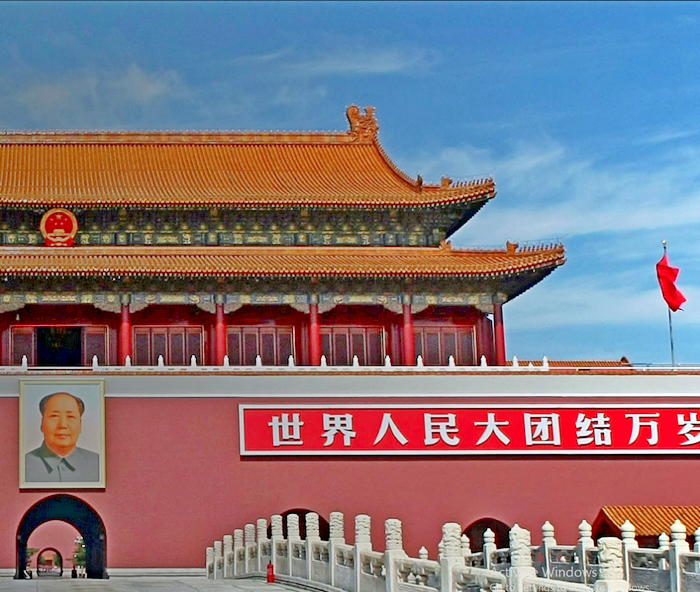

From investing in Pakistan to deploying peacekeepers in South Sudan, China’s growing clout is being felt around the globe. But does the country’s influence come with a price?
In little more than three decades, China has transformed itself from a closed-off Asian nation mired in poverty to an emerging superpower that rivals the United States. Now, the tendrils of Chinese influence are gradually wrapping themselves around the world, upending roles and relationships that have dominated the global order for half a century. The latest step in China’s evolution as a global power is President Xi Jinping’s grand plan for the world economy that draws on the millennia-old tradition of the Silk Road trading route. We explore five ways China is changing communities and lives across the globe – with its financial clout and its influence on culture, education, travel and the military balance of power.
China’s global investment
Plotting Chinese investment deals worth $100 million or more (2005-2014)
Source: The Heritage Foundation
Part one Investment
Islamabad’s Chinatown
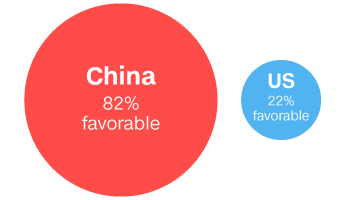
How Pakistanis view China and the US (Source: Pew Research Center 2015)
Islamabad, Pakistan -- In a bustling street in Pakistan’s capital the air is thick with the familiar smell of mutton sizzling on charcoal. The plumes of smoke rising into the night sky are illuminated by something once uncommon here -- the blinking red neon of a sign bearing the restaurant’s name in Chinese.
Gulab Khan Shinwari, the owner, stands at its entrance welcoming a steady stream of Chinese customers. “My restaurant is called Khyber Shinwari but everyone here calls it the CPEC Hotel, since so many Chinese customers have started arriving since the deal was announced.”
The China-Pakistan Economic Corridor, popularly known by its acronym of CPEC, has become a buzzword for longed-for economic prosperity in Pakistan. An integral part of China’s One Belt, One Road initiative, the corridor is a combination of projects ranging from road networks, a fiber optic cable project, railway lines, a deep-sea port, coal mines and solar farms that Pakistan views as a huge opportunity to develop its economy.
Following the ancient Silk Road that stretches from the Himalayas in Pakistan’s northern border with China all the way down to the Arabian Sea, the corridor was announced with much fanfare in 2015 when Chinese President Xi Jinping visited Islamabad and announced a $46 billion investment plan, roughly 20% of Pakistan’s economic output.
With the implementation of these projects and their promised riches, Pakistan has seen the influx of a large expat community, roughly 20,000, according to Mustafa Hyder, chief executive of the Pakistan-China Institute.
It’s a community whose influence is slowly trickling into Pakistan’s daily life.
In April, a commercial released by Shan Foods, a Pakistani company that sells spice mixes, showed Pakistani and Chinese neighbors bonding over a shared love for biryani, a popular rice and meat dish. The ad immediately went viral, with more than 59,000 shares on Facebook in the first week of its release.
The sleeping dragon has finally awoken”
While the ad might not have initially been made with CPEC in mind, there’s no doubt the foreigners Pakistanis interact with most on a daily basis are Chinese. “They’re our best neighbor,” says Humayun Farooq, marketing general manager for Shan Foods.
“If this ad has given CPEC a human face then I am glad for that.”
Across town, Pakistanis discreetly sip cheap Chinese beer and wolf down dumplings made by Amber Shen, from China’s Anhui province. Shen and other Chinese expats do their shopping from a handful of Chinese grocery stores that have sprung up in Islamabad. Popular American treats, like Chips Ahoy and Skittles, with Chinese packaging and even cans of stewed pork, a meat banned in Pakistan, are all available.
Last year, a bilingual newspaper called Huashang Weekly launched with a staff of both Chinese and Pakistani journalists. It publishes and distributes 30,000 copies each week to Lahore, Islamabad and Karachi.Pakistan movie theaters are showing “Chalay Thay Saath,” which is about a Chinese man finding his roots in Pakistan.
"There's a lot of curiosity amongst private Chinese investors about the potential in Pakistani markets, there's just the language barrier that I wanted to erase through Huashang Weekly so these investors can have an understanding of what's happening in Pakistan. These are very interesting times," says Derrick Wang, the paper's publisher who came to Pakistan five years ago.
Meanwhile in cinemas, one of the latest movies “Chalay Thay Saath” (Together We Went), stars a Chinese-Canadian lead actor and is about a Chinese man finding his roots in Pakistan.
In Islamabad, a city that has never really had a Chinatown, these developments are unusual. But China’s embrace of Pakistan has risks attached. Analysts say Pakistan will owe China $90 billion if all the planned projects go ahead. But criticisms about Chinese investment aren’t evident on the streets of Islamabad.
Times are changing and Pakistan must keep up, says Sabina Zakir, an administrator at the Roots millennium schools, an education system that has introduced compulsory Mandarin lessons for all students starting at age 8 and going all the way up to middle school.
“The sleeping dragon has finally awoken,” she says about the country’s northern neighbor. “And our children, the custodians of our future, must be prepared to deal with this new roaring beast!”
Part two Education
How Chinese students are changing US campuses
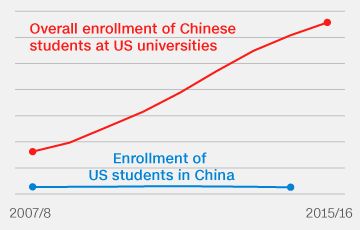
Launch detailed chart of enrollment of Chinese and US students
Urbana, IL -- When Gregory Davis, a US accounting professor, opened his first roster at the University of Illinois at Urbana-Champaign three years ago, he was shocked by the number of Chinese students in his class.

“Oh my gosh,” he recalled thinking. “How am I going to pronounce these names?”
Davis previously taught on the East Coast and thought the student body in this Midwestern town surrounded by soy and corn fields would be predominantly domestic. This year, he says, his graduate class is at least 80% Chinese.
The number of Chinese students at UIUC has risen fivefold to 5,629 since 2008 -- they make up a trend that’s playing out in college towns across the United States as cash-strapped public institutions welcome the higher fees paid by international students.
It’s easy to see the impact the Chinese students have had on this town of 207,000 -- bubble tea stores, Sichuan food joints and Chinese hair salons have popped up. One street has at least six Chinese restaurants.
The number of Chinese students in the US has more than tripled since fall 2008 to 329,000. The Chinese students, who believe a US degree will dazzle employers back home, are also transforming US classrooms and shaping the way professors like Davis teach.
There’s a lot of walls put up in the classroom”
“I try to address in my first couple of classes that I’m okay with wrong answers in class because that’s how the learning helps.”
It’s a shift in teaching patterns shared by many other professors, according to Yingyi Ma, a Syracuse University sociologist who is working on a book on Chinese international students in the US.
"Their (Chinese) classroom participation patterns right now really have pushed a lot of professors to think about how they can adjust the way they teach," says Ma.
To bridge the divide between domestic and Chinese students, Davis makes sure group projects and classroom seating aren’t split along ethnic lines.
While most domestic students appreciate the diversity, some feel negative about the big Chinese presence, Davis says. They feel sore that international students take seats away from their high school friends.
It works the other way too. Before coming to college, Wang Dinghong said he’d imagined having a lot of American friends, but the sheer number of Chinese students means he has very few.
“The only way to solve this issue -- and this might not sound very good -- is to reduce the number of Chinese students admitted every year,” Wang says.Chinese students at the UIUC campus on April 21, 2017. (Shen Lu/CNN)
Charles Tucker, UIUC’s Vice Provost for Undergraduate Education and Innovation, says administrators are well aware of the lack of integration between Chinese and US students and are making efforts to correct it.
“Just as there is no learning without teaching and without student effort, there is no cultural learning or cultural integration without some programmatic effort and some individual effort,” he says.
Ma says there’s much discussion on university campuses about the lack of integration but few have found a way to address it.
There’s a lot at stake. She says for Chinese students, it’s a lost opportunity to be fully immersed in US culture and get truly fluent in the slang-laden conversational English of their American peers. US students miss out on learning about the culture of a rising superpower. For the university, she says, graduates with little sense of school spirit aren’t likely to be the university’s best ambassadors when they return home.
China’s weight on US campuses is also felt by the 110 Confucius Institutes Beijing has opened nationwide. Their goal is to promote Chinese culture and language but several US institutions have cut ties over fears that a hidden ideological agenda undercuts academic freedom.
Davis, the accounting professor, says diversity will ultimately benefit all students.
“There’s a lot of walls put up in the classroom,” Davis says. “But if you actually spend that time to break down that wall, wow, it just makes the whole class and learning environment a whole lot better.”
Part three Infrastructure
All aboard! How Chinese money is transforming Africa
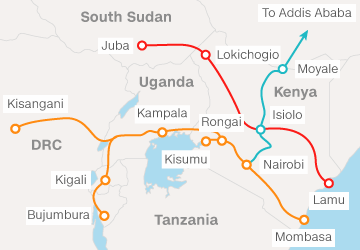
Launch detailed map of Chinese railway projects in East Africa
Nairobi, Kenya -- Kenyan and Chinese workers are putting the finishing touches on the biggest infrastructure project in Kenya’s post-independence history – a $3.8 billion, 472-km (293 mile) railway that runs from the port city of Mombasa to the capital Nairobi, part of a larger Chinese-built rail network linking several countries.
When the locomotives and freight wagons begin rolling in June, the line could be a game-changer for Kenya. Home to East Africa’s largest port, the country moves its goods by a notoriously dangerous two-lane highway.
The new railroad is expected to handle 50% of freight from Mombasa to the border with Uganda, compared to just 4% taken by the old British colonial-built railway, according to Alexander Wang, an associate professor at the Shanghai International Studies University, who has conducted field work on the railroad.
China’s presence in Africa has been the subject of heated debate, with investments dogged by allegations of shoddy workmanship, poor treatment of workers and a lack of transparency.
The company behind the Kenyan railway project, Chinese state-backed China Road and Bridge Corporation, has tried to ward off criticism by employing 25,000 Kenyan workers and training all crew members including drivers. It’s also built special underpasses to allow wildlife to cross the railroad, which plows through two national parks. However, last year at least eight elephants were killed while confused by the construction work, according to monitoring by Kenyan NGO Save the Elephants.
The railway line’s price tag has raised eyebrows. Funded by loans from state-backed China Export Import Bank (Exim), it’s twice as expensive per kilometer as the 750-km Addis Ababa-Djibouti Railway, also built by the Chinese.
Kenya Railways, which will operate the line, didn’t respond to multiple requests for comment but officials have been quoted as saying in the past that the two projects shouldn’t be compared, as the Kenyan railroad has greater freight capacity and travels through more urbanized areas, making it more expensive. China Road and Bridge Corporation referred questions to its Chinese headquarters, which didn’t immediately respond when contacted by CNN.African, right, and Chinese workers, left, build railway track sections for the new Mombasa-Nairobi line in Tsavo, Kenya, in March 2016. (Riccardo Gangale/Bloomberg via Getty images)
“In Africa sometimes our policy makers think the Chinese are Santa Claus,” says Ali Khan Satchu, a financial analyst in Nairobi. “No, they’re there to make a return on their investment.”
In the 10-year period between 2004 and 2014, African countries borrowed nearly $10 billion for railway projects from China, facilitated by Exim. China sees the railways as an investment opportunity, which also creates an export market for their booming steel and construction industries.
At the railroad’s first stop out of Nairobi, locals like security guard Joseph Mailoya have little criticism for the project. “I think it’s a great idea,” he said. “Things are going to change around here.”
He motions towards hundreds of corrugated tin houses across from the terminal, a settlement for new inhabitants drawn by the railway.
“These people are going to start businesses, the community will get developed,” he says. “My kids may even be employed here.”
Part four Travel
China’s big spenders
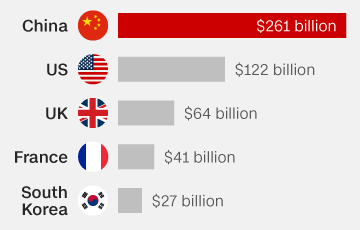
Big spenders: Which country spends most on vacations (Source: UNWTO 2016)
Kidlington, UK -- Annabel Edwards, a British mother of four who lives in this quiet English village, remembers the first time it happened.
“There were 50 or 60 Chinese tourists walking up and down, in and out of people’s gardens, taking pictures of flowers and wheelie bins,” she says.
The mysterious visitors started taking an interest in her unremarkable street almost a year ago -- putting her home of Kidlington under a rare international spotlight.
Rumors said the tourists were misinformed that Kidlington was a film setting for “Harry Potter.” Another report said they were left in the village after refusing to pay extra for a ticket to the nearby Blenheim Palace. The BBC said they were attracted by the quiet houses and gardens.On average, Chinese tourists spend three times more than other visitors to the UK. Bicester Village, a designer outlet near Oxford, is one of the most popular stops among Chinese tourists. (Maggie Hiufu Wong/CNN)
No one seems to have the ultimate answer but one thing is for sure: Edwards and her fellow villagers encountered what’s perhaps been the biggest phenomenon to hit the global travel industry since the invention of commercial flight -- Chinese tourism.
Last year, 135 million Chinese tourists traveled overseas spending a whopping $261 billion, way more than anyone else including Americans, who spent $122 billion, according to the United Nations World Tourism Organization.
A weak pound post-Brexit, more flexible visa requirements and better connections with China have made the UK much more appealing to Chinese tourists. Some 270,000 visited the UK in 2015 -- a 46% increase from a year earlier.
“I like everything about the trip. My favorite thing about the UK is its beautiful scenery -- no matter it’s the countryside or the city,” says Fu Shenghong, who’s just returned from a group tour of the country.Chinese tourists, spied from a resident's window, visit the English village of Kidlington in November 2016. (Courtesy of Stephen Bruce)
Britain, like other European countries, is unfurling the welcome mat. Compared to other international travelers, Chinese visitors stay longer (15 nights compared to eight for other visitors to the UK) and spend more ($2,807 for each visit, three times more than an average visitor), according to Visit Britain, which promotes tourism.
Visit Britain is also trying to make the UK more “China ready.” Among the 500 businesses signed up for the Great China Welcome program are hotels that serve Chinese breakfast food and offer Chinese TV channels, and retailers that accept Chinese payment methods like UnionPay or Alipay.
While the selfie-taking, bus-travelling tourist stereotype isn’t completely off the mark -- group travel is still very much in demand in China -- there is an increase in individual travel and a growing desire for a more authentic travel experience.
“My best memory is a homestay with an artist in a hidden cottage,” says Ken Chan, an IT manager from southern China, who spent a month traveling around the UK last year.
As for the Benmead Road residents in Kidlington, Chinese tourists are still coming to their village once or twice a week but have stopped trampling on their flower beds. “It’s bizarre, funny but also very sweet,” says Edwards.
Part five Military
A global military player
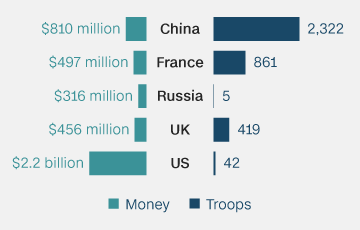
Peacekeeping commitments by UN Security Council permanent members (Source: UN)
It’s in South Sudan where China has learned the hard realities of global power.
In July 2016, two soldiers involved in United Nations peacekeeping efforts in the capital Juba returned home in caskets. The Chinese military hadn’t seen combat deaths in more than three decades.
“For the government, it was a shock. They don’t want a death toll from what they see as efforts to project soft power,” said Shen Dingli, a professor of international relations at Fudan University in Shanghai.
The presence of Chinese peacekeepers on African soil is just one facet of China’s quest to become a global military player rivaling the United States.
It’s building its first military base in Djibouti, just a few miles away from Camp Lemonnier, the US base that opened in 2008, and it’s developing a “blue-water” navy capable of operating in open oceans -- in April its first domestically built aircraft carrier was launched. And China’s military hardware, while not yet rivaling the US, is getting increasingly sophisticated.
Beijing first sent troops into a combat zone in 2013, dispatching peacekeepers to Mali, and in 2015 sent troops to South Sudan, where part of the mission is to guard oil installations, some of which are Chinese invested. Three Chinese warships have joined the international naval flotilla battling piracy in the Gulf of Aden.
China supplies 2,322 troops to UN peacekeeping efforts worldwide -- by far the most of any UN security council member -- and has pledged 8,000 for a fast-response force. The US has just 42 troops but fronts the largest share of the UN peacekeeping budget -- although US President Donald Trump wants to cut that by half.
Shen says it’s about boosting China’s global standing as a responsible military power and training China’s troops, which haven’t seen combat since 1988.
However, Lt Col. (ret) Dennis J. Blasko, a former US army attaché to Beijing and Hong Kong, says it’s about garnering “maximum political and propaganda value from a minimal investment in personnel and money.” China’s Ministry of National Defense told CNN China has always actively participated in UN peacekeeping missions, saying "we are willing to contribute more to global peace and security."People’s Liberation Army officers mourn the two Chinese UN peacekeepers killed in South Sudan. (VCG/VCG via Getty Images)
In October, China denied accusations its peacekeepers failed to protect aid workers, who were attacked in a hotel the same day the two soldiers were killed, calling the accusations “malicious speculation.”
A UN report into the incident found that Chinese troops had left their posts. The report blamed a poor chain of command among the peace keeping contingents from China, Ethiopia, Nepal and India for a “chaotic and ineffective response to the violence.”
The deaths and ensuing scandal in South Sudan haven’t loosened China’s embrace of the blue berets.
The US Department of Defense in its latest briefing to Congress on China in December said peacekeeping allows Beijing to achieve “various objectives” -- including improving its international image and gathering intelligence.
Nine of the 16 UN missions are in Africa, where China has significant investments.
Greater involvement in peacekeeping may also give China more clout in decision making at the UN and positions Beijing to have a bigger say in future settlements in the Middle East, which Beijing relies upon for its oil.
“China wants both soft and hard power,” says Shen. “And this makes us more visible on the international stage.”
Credits
Producer Katie Hunt
Editor Marc Lourdes
Contributors Sophia Saifi in Islamabad, Briana Duggan in Nairobi, Shen Lu in Illinois & Maggie Hiufu Wong in London
Design & development Jason Kwok & Marco Chacón
Video & photos Zahra Ullah, Javed Iqbal, UN & Getty Images
China exports tools of repression to the world
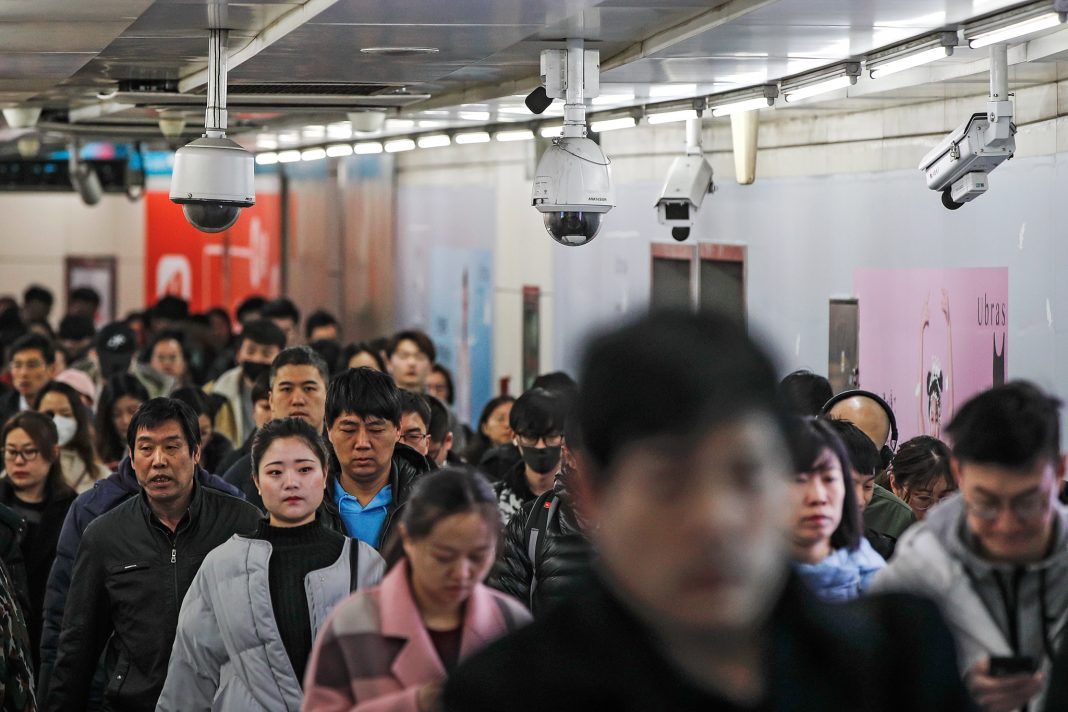
Commuters walk by surveillance cameras installed at a walkway in between two subway stations in Beijing in February. (© Andy Wong/AP Images)
By Leigh Hartman -May 6, 2019
Oppressive governments are buying Chinese technology that allows them to track and monitor their citizens, according to a senior State Department official.
“China exports technological know-how that can help authoritarian governments track, reward, and punish citizens through a system of digital surveillance,” Kimberly Breier, assistant secretary of state for Western Hemisphere affairs, said in an April 26 speech at the Council of the Americas.
China pioneered this technology in regions such as Tibet and Xinjiang to spy on Tibetans, Uighurs, ethnic Kazakhs and members of other minority groups.
The deals exporting this high-tech surveillance and tracking equipment are often part of China’s Belt and Road Initiative, according to a recent report, “Grading China’s Belt and Road,” from the Center for a New American Security.
Zimbabwe, for example, as part of its Belt and Road trade deal “is importing China’s facial recognition system and will likely apply it in ways that will reduce the cost of authoritarianism,” the report says.
China exports its philosophy
The “‘China model’ of economic development and Internet control is becoming more appealing to authoritarian-leaning leaders around the world,” Adrian Shahbaz, research director for technology and democracy at Freedom House, said in a February survey on the links between technology and authoritarianism.

In Freedom House’s report “Freedom on the Net 2018,” 18 out of 65 countries analyzed had purchased systems from Chinese companies such as Yitu, Hikvision and CloudWalk. These companies combine “advances in artificial intelligence and facial recognition to create systems capable of identifying threats to ‘public order.’” All these companies advanced their technology in Xinjiang, monitoring Uighurs.
“Beijing took steps to propagate its model abroad by conducting large-scale trainings of foreign officials [and] providing technology to authoritarian governments,” the Freedom House report says.
The regimes buying China’s monitoring systems include Venezuela, which also contracted with Chinese telecom firm ZTE to create a national identity card that connects to a database the government uses to control and repress Venezuelans, according to Breier.
A bleak future
Chinese President Xi Jinping said in a 2017 speech to the Communist Party of China’s 19th Congress that “the path, the theory, the system” of China’s model of government “offers a new option for other countries and nations.”
The Freedom House report describes it differently, saying China is “remak[ing] the world in its techno-dystopian image.”

As the world begins building 5G networks, U.S. officials are raising the alarm that the new technology will help authoritarian regimes to further repress and control their own citizens.
With 5G networks’ faster connections and greater bandwidth, “tens of billions of new devices will be connected to the internet in the next few years,” U.S. cyber diplomat Robert Strayer says.
For most people, 5G technology will improve their quality of life. But for some, it could be used to constrain their freedoms. Companies headquartered in the People’s Republic of China (PRC) are already developing and using advanced surveillance technologies, which are used to control populations at home and abroad.
Beijing’s data prison
The Chinese government uses technologies to undermine human rights and fundamental freedoms. It gathers and exploits data on an unrivaled scale and uses information to promote corruption and repression, conduct arbitrary mass surveillance and silence dissent. Beijing’s future acquisition of advanced technology will only exacerbate this situation.
The PRC is currently using “technology for pervasive and arbitrary high-tech surveillance and involuntary collection of personal data,” Strayer says.
In Freedom House’s report “Freedom on the Net 2018,” 18 out of 65 countries analyzed had purchased systems from Chinese companies such as Yitu, Hikvision and CloudWalk. These companies combine “advances in artificial intelligence and facial recognition to create systems capable of identifying threats to ‘public order.’”
The emerging technology of 5G will make such close monitoring and control of citizens even easier.
Beijing’s export: oppression
“Chinese technology firms are already working with authoritarian regimes around the world — often hand-in-hand with the Chinese government — to suppress freedom of expression and other human rights,” Strayer says. “With all of these [internet-connected] services relying on 5G networks, the stakes for safeguarding these critical networks could not be higher.”
With the adoption of 5G networks, much of this surveillance will be automated, and the PRC could export their repressive model of governance. That’s one of the reasons America is concerned about 5G.
Zimbabwe, as part of its Belt and Road trade deal, “is importing China’s facial recognition system and will likely apply it in ways that will reduce the cost of authoritarianism,” according to a report earlier this year.
“If Chinese companies build the underlying 5G infrastructure, they will be in an even better position to facilitate these activities around the globe,” Strayer says.
5G is the ‘Stupidest Idea In The History of The World’

HEALTH | SCIENCE & TECH | APR 13, 2019 AT 10:46 PM.
Prominent Biochemistry Professor Warns – 5G is the ‘Stupidest Idea In The History of The World’
The international rollout of 5G wireless technology is well underway despite increasingly vocal opposition from scientists and medical professionals. Many scientists, doctors and professionals are issuing dire warnings about 5G.
The international rollout of fifth generation wireless technology (5G) is well underway despite increasingly vocal opposition from scientists and medical professionals, who are desperately trying to warn us of the well-documented dangers of 5G. The government and industries involved in the 5G rollout are have zero concern for public safety, because the technology promises to be exceptionally profitable, while also forcing everyone everywhere into the emerging technocracy.
Adding to the voices of dissent is Martin L. Pall, PhD and Professor Emeritus of Biochemistry and Basic Medical Sciences at Washington State University. In a study and presentation, he takes a closer look at 5G technology, and issues a major warning for all of us.
“Putting in tens of millions of 5G antennae without a single biological test of safety has got to be about the stupidest idea anyone has had in the history of the world.” ~Martin L. Pall, PhD
The report offered 4 explanations for why 5G is significantly more dangerous than earlier generations of wireless technology, noting?
5G is predicted to be particularly dangerous for each of four different reasons:
- The extraordinarily high numbers of antennae that are planned.
- The very high energy outputs which will be used to ensure penetration.
- The extraordinarily high pulsation levels.
- The apparent high level interactions of the 5G frequency on charged groups presumably including the voltage sensor charged groups.
He begins by speaking about the current safety guidelines for 2g/3g/4g technologies, rightly pointing out that government approved guidelines ignore any adverse reactions that occur at dosages or exposures below said guidelines. In other words, as Pall points out, they are meaningless when it comes to safety.Get the latest from The Mind Unleashed in your inbox. Sign up right here.
He goes on to discuss eight ways in which this technology adversely affects human health, citing extensive scientific documentation:
Não Precisa Fazer Dieta Ou Frequentar a Academia Se Fizer Isso Antes De DormirDetox10FIND OUT MORE >
- Lowered Fertility
- Neurological/Neuropsychiatric effects
- Cellular DNA damage
- Aptosis – Programmed Cell Death
- Oxidative Stress and Free Radical Damage
- Endocrine (Hormonal) Effects
- Excessive Intracellular Calcium
- Cancer
Pall’s conclusion does not mince words when describing 5G, saying, ‘the 5G rollout is absolutely insane.” The following presentation is exceptionally valuable for anyone wanting to better understand what this is about, and also how to fight against it.
Watch the presentation below, and please hare with friends and family.
Dr. Pall is only one of many professionals issuing the same warning, yet the rollout is moving forward without delay. Here, Dr. Martin Blank from Columbia University’s Department of Physiology and Cellular Biophysics, summarizes his assessment.
“We have created something that is harming us, and it is getting out of control. Before Edison’s light bulb there was very little electromagnetic radiation in our environment. The levels today are very many times higher than natural background levels, and are growing rapidly because of all the new devices that emit this radiation. Putting it bluntly they are damaging the living cells in our bodies and killing many of us prematurely.” ~ Dr. Marin Blank
Here, Dr. Sharon Goldberg, an internal medicine physician & professor, comments on 5G while speaking to the U.S. Senate.
“Wireless radiation has biological effects. Period. This is no longer a subject for debate when you look at PubMed and the peer-review literature. These effects are seen in all life forms; plants, animals, insects, microbes. In humans, we have clear evidence of cancer now: there is no question We have evidence of DNA damage, cardiomyopathy, which is the precursor of congestive heart failure, neuropsychiatric effects…5G is an untested application of a technology that we know is harmful; we know it from the science. In academics, this is called human subjects research.” ~Dr. Sharon Goldberg
And finally, UN Staffer Claire Edwards had this strong warning for high level members of the United Nations, calling 5G a ‘war on humanity.’
WHO and WHAT is behind it all ? : >
The bottom line is for the people to regain their original, moral principles, which have intentionally been watered out over the past generations by our press, TV, and other media owned by the Illuminati/Bilderberger Group, corrupting our morals by making misbehavior acceptable to our society. Only in this way shall we conquer this oncoming wave of evil.
Commentary:
Administrator
HUMAN SYNTHESIS
All articles contained in Human-Synthesis are freely available and collected from the Internet. The interpretation of the contents is left to the readers and do not necessarily represent the views of the Administrator. Disclaimer: The contents of this article are of sole responsibility of the author(s). Human-Synthesis will not be responsible for any inaccurate or incorrect statement in this article. Human-Synthesis grants permission to cross-post original Human-Synthesis articles on community internet sites as long as the text & title are not modified.
The source and the author's copyright must be displayed. For publication of Human-Synthesis articles in print or other forms including commercial internet sites. Human-Synthesis contains copyrighted material the use of which has not always been specifically authorized by the copyright owner. We are making such material available to our readers under the provisions of "fair use" in an effort to advance a better understanding of political, economic and social issues. The material on this site is distributed without profit to those who have expressed a prior interest in receiving it for research and educational purposes. If you wish to use copyrighted material for purposes other than "fair use" you must request permission from the copyright owner.